How to Use Reward Scaling to Teach Your Dog to Listen
Some of the links below are affiliate links. These won’t cost you anything, but the commissions we may earn through them help offset the cost of dog treats. Thanks for your support!
Using food rewards in training is pretty universal. Most people buy some goodies and then machine-gun them down their dog’s throat. But there is a strategy to using food, and I’m going to show you how scaling will teach your dog to listen while getting you closer and closer to prompt, precise, and polite behaviors.
Using Reward Scaling
In dog training, working with food involves the fastest, easiest, and most effective strategies…if they’re done right. Using food rewards is pretty well accepted now amongst dog owners, trainers, and behaviorists alike. But it’s a slippery slope. It’s easy to get stuck using treats as bribes or (worse) ramping up treat value over time to keep interest high.
Reward scaling is used to reward excellent effort. We use it to help a dog understand something new or to overcome fears or a dislike of something. If used correctly, food training can quickly flatten the learning curve. For example, we may use a basic reward for training a simple move but then kick it up if we’re helping a dog overcome reactivity. We may use a basic reward to teach sit or come, but then give them better rewards for faster or more stylish responses.
How Do We Do That?
For starters, we want to have at least three tiers of rewards to use:
- Jackpots
- Treats
- Kibble
Let’s break these down a little bit.
Jackpots
These are any food item of ultra-high value. This is the highest value tier and is only used occasionally. Dogs typically take longer to chew and swallow these, so save them for the best effort and for reaching a new goal. The jackpot of jackpots is called the $10,000 treat, which they only get on rare occasions.
Treats
Treats are the middle tier, and while they’re not as enticing as jackpots, they’re still pretty darn good. This is the group of food rewards you probably normally think of when you think “training treat.” Small, smelly, and a good brand are the best choices.
Kibble
The bottom tier is kibble—good old dry dog food. This can and should be used as an effective training reward. Initially, you want to empower kibble to be a reward In the first place. Remember: it’s not what it is; it’s what you’ve trained it to be. So, for puppies up to 18 weeks, you should be exclusively either hand-feeding or feeding from chew toys. And for adolescent and adult dogs, you should be using regular feeding times and picking up what’s left after 15-20 minutes. Do not just put food down all day.
Listen: mealtime is a trainable activity just like any other. If you are not hand-feeding or toy-feeding your puppy or free feeding your adolescent or adult dog by leaving the food bowl down all day, you are WASTING a tremendously teachable opportunity. You will not be able to use reward training as effectively as possible because you are teaching your dog—an animal classified as a scavenger—to take food for granted.
Look at it this way: You can’t get someone who lives in a pizza parlor to help you move by offering them pizza. Do you see what I’m getting at here?
Kibble works excellently for training because it’s nutritionally balanced. You’ll be using a good deal of it, so why not use the healthiest thing available? Many canine nutritionists recommend that treats only make up 10% of your dog’s daily caloric intake, so using kibble to train makes perfect sense.
Deploying the Rewards
The Basics
Start with kibble for basic behaviors. This will make up most of your work with your dog. Use a treat or a jackpot for difficult things and for stellar performance. Here are some more specific suggestions (your results may vary): For basics like sit, down, stand, or stay: use kibble to train duration. Use treats for proofing distance and a jackpot for when they nail both during a big distraction.
For Take it, Leave It, Drop it: start with kibble, then progress to treats and even jackpots to proof it. If your dog can leave a piece of meat on the floor, they’ve really got it down! For tricks like rollover or play dead you can probably use a treat in most cases. Going on their backs can be spooky for some dogs, so use a higher-value reward to get the job done. Then you can use kibble for practice and use treats to shape it and improve performance.
Intermediate Stuff
For long-distance training: I would probably use treats, initially, and jackpots for a fantastic job. Then, use kibble for that, raise the criteria, and reward the new expectation with treats. This way you keep building and improving. For handling routines: that’s getting a dog accustomed to having paws, ears, mouth, and genitals touched so they’re calm and agreeable at the vet and the groomers. We do this in all of the puppy classes. Depending on your dog’s sensitivity, treats or jackpots will probably work best to begin conditioning them to love being handled.
Advanced Stuff
Another cool way we use reward scaling is when we’re working with anxious or reactive dogs: use treats for normal work and then jackpots for when their reaction (or rather, their lack of reaction) reaches a new milestone. Make sure to consult a professional to help you in these cases.
We can also use reward scaling to teach volume and urgency. In emergencies, we tend to get loud, even yelling. When I get louder, I want a dog to think, “Oh man, this must be important!” I don’t want a dog to think they’re in trouble, making them hesitate and possibly make the wrong decision.
So, for example, you could practice recalls with your dog and scale up the reward the louder you get. Kibble for tone neutral, treats for calling loudly, a jackpot for shouting, and then a $10,000 jackpot for outright yelling. Then, the next time you yell when they squirt out the front door, they’ll pay way better attention.
Get Creative
This is just a beginning list; your creativity and ingenuity will open up many doors here for you. A lot of these suggestions depend on your dog’s tastes. I could use kibble with almost anything with my dogs (although they’re such chow-hounds, I think I could probably treat them with scrap metal, and they’d be happy).
As we discussed in the post on phasing out treats, reducing the number of rewards is essential in phasing out food. One way that we do this is we reduce or scale back rewards. Behaviors receiving a jackpot may only get a treat after several repetitions and even kibble after many more. Remember, the key phrase is “more for less.” Generally, we’ve raised the bar a notch so they can still get the treat or the jackpot; they have to work a little harder for it now.
Recommendations
Jackpots
Hands down, my all-time favorite jackpot is the Stewart Pro Treats Freeze-Dried Liver. Most dogs really go crazy for these and believe me; there have been numerous times when this was the stubborn dog’s kryptonite. They break apart easily to use with the little guys, too. I use the beef version, but chicken and lamb are also available.
 DOGforDOG Peanut Butter Dogstreats are awesome too. They’re not as popular with dogs as the liver treats, but they’re certainly nothing to sneer at either.
DOGforDOG Peanut Butter Dogstreats are awesome too. They’re not as popular with dogs as the liver treats, but they’re certainly nothing to sneer at either. 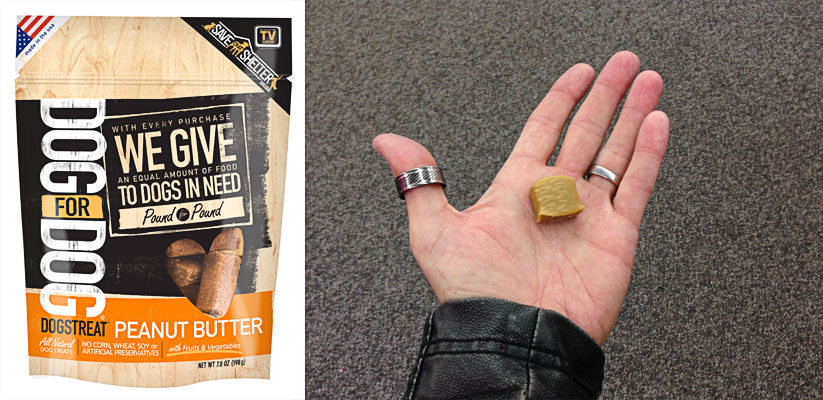 In a pinch, I’ve also pulled chunks off of rolls like Pet Botanics dog food rolls or Natural Balance Dog Food Roll: These are so rich and smelly that they function well as a jackpot. These have also cracked some pretty tough nuts.
In a pinch, I’ve also pulled chunks off of rolls like Pet Botanics dog food rolls or Natural Balance Dog Food Roll: These are so rich and smelly that they function well as a jackpot. These have also cracked some pretty tough nuts. 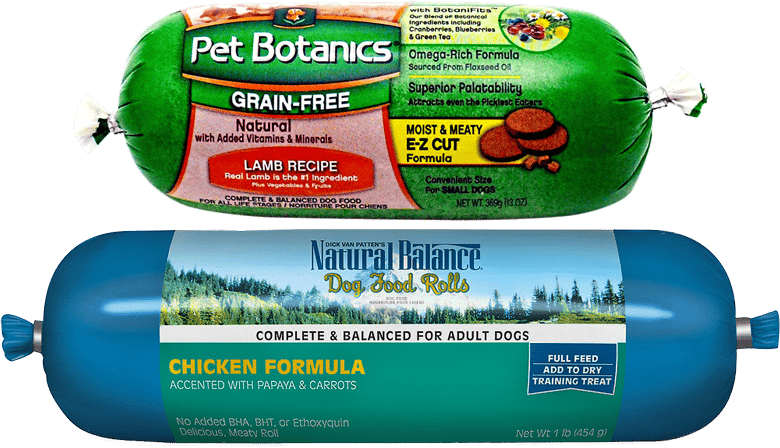 Finally, pieces of bacon, cheese, or chicken skin are super-enticing jackpot options too, although these are harder to handle because they can be greasy. You may want to save these for the “$10,000 jackpot” situation when the dog really nails it. A lot of dogs view many vegetables as jackpots too. My dogs go bananas for, well, bananas, as well as carrots and broccoli. What a cost-effective solution that is! Stay away from the junky stuff like Pupparoni, Beggin’ Strips or Milkbones; these and others like them are just as crappy as McDonald’s food.
Finally, pieces of bacon, cheese, or chicken skin are super-enticing jackpot options too, although these are harder to handle because they can be greasy. You may want to save these for the “$10,000 jackpot” situation when the dog really nails it. A lot of dogs view many vegetables as jackpots too. My dogs go bananas for, well, bananas, as well as carrots and broccoli. What a cost-effective solution that is! Stay away from the junky stuff like Pupparoni, Beggin’ Strips or Milkbones; these and others like them are just as crappy as McDonald’s food.
Treats
Go ahead and use the “training treats” you’re probably already buying. Get small and smelly things so they’re enticing and can be chewed and swallowed quickly. The Pet Botanics Training Rewards are my go-to favorites. They’re USA made and relatively healthy. These also break into halves or thirds very easily, which is great for keeping a dog from filling up and making training go a little farther.
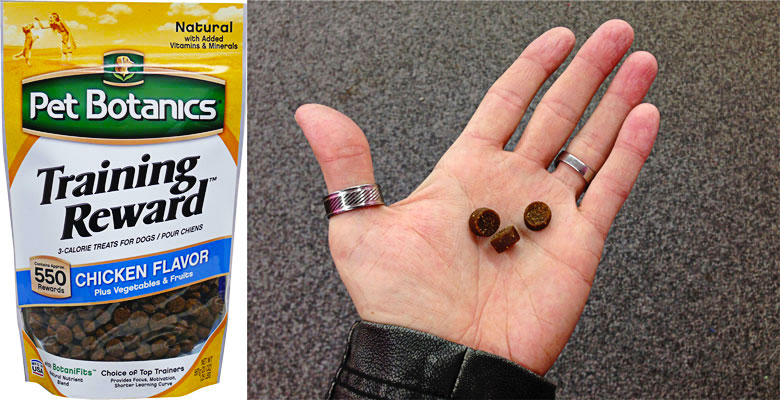
The regular training rewards are soft enough to break into halves or even thirds. That’s usually what I do with them. However, if you don’t want to mess with that, they also makes a smaller version: the Pet Botanics Mini Training Reward.
Blue Buffalo Blue Bits are my second choice. They’re also healthier than average, and they’re USA made as well. These are also soft and smelly and break into smaller pieces just like the Pet Botanics ones do.  If you shop around with this style in mind, you’ll probably be able to find some more like these. Again, stay away from things that are bulky or dry and crunchy. They take too long to chew and swallow, and most brands aren’t that great anyways.
If you shop around with this style in mind, you’ll probably be able to find some more like these. Again, stay away from things that are bulky or dry and crunchy. They take too long to chew and swallow, and most brands aren’t that great anyways.
Kibble
You’ll ideally want to use your dog’s dry food. There’s nothing inherently wrong with buying something else for training, but use caution since some dogs get pretty rocked by different foods. Ostensibly you should pick a good quality food to begin with and then use part of their daily ration to train. I particularly like DogForDog or Victor brands. Both are great dog foods with very small kibble which works great for training. Remember, you’re going to use a lot of it. 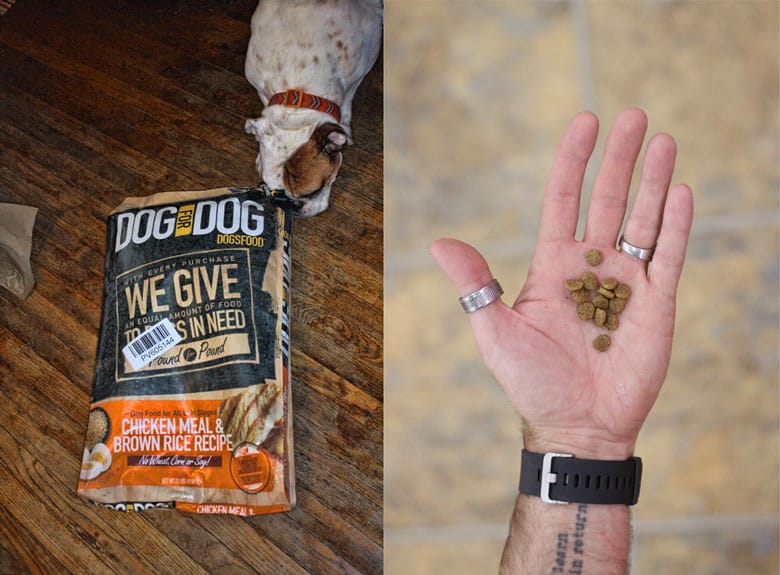
 If you have a large dog, you might get a little bag of the small-breed version of their food to use for training. Small-breed versions typically have a smaller kibble which will work great for training. Double-check with your nutritionist and/or vet.
If you have a large dog, you might get a little bag of the small-breed version of their food to use for training. Small-breed versions typically have a smaller kibble which will work great for training. Double-check with your nutritionist and/or vet.
You can always check the overall rating of any food you want to use on Dog Food Advisor. They’re an independent testing and rating organization with an excellent track record for honest analysis and reviews.
Selecting your own
The previous recommendations are food rewards that I’ve personally used. They’re certainly not the only ones there you can use. When you’re shopping for your arsenal, make sure (at the very least) that the first ingredient is meat.
NOW GET TRAINING!
So there you have it. Good luck with using reward scaling, and don’t forget to start phasing it out as early as possible.
Also, once you’ve got your food rewards picked out, take a look at how to handle them effectively in your training.
Now, here are your questions: what are your favorite picks for treats and jackpots? What brands do you like, which ones do you avoid, and what are some things you use that maybe we haven’t thought of? Let me hear from you in the comments.
Don’t forget to thumbs up the video on YouTube if you learned something useful, and remember to keep learning and keep practicing. Thanks for reading!



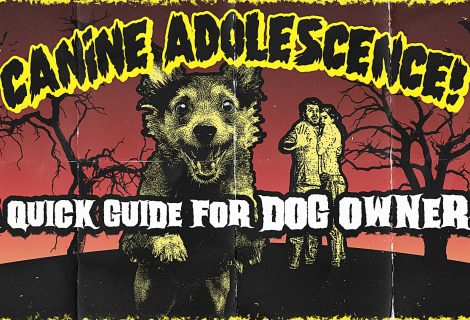






Trackbacks for this post